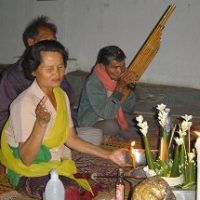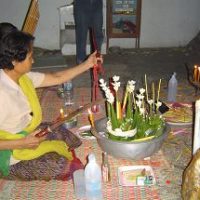Phi Fa : The Benevolent Spirit
Listen
At a glance
| Description | |
|---|---|
| Origin | Thai Mythology |
| Classification | Spirits |
| Family Members | N/A |
| Region | Thailand, Laos |
| Associated With | Sky, Recovery from Illness |
Phi Fa
Introduction
Phi Fa is a deity or spirit in the local folklore of Thailand and Laos. This celestial figure plays a prominent role in tales such as Phra Lak Phra Lam and the stories of Khun Borom. Within Thai mythology, Phi Fa is revered as a benevolent spirit, particularly in the region of Isaan, also known as Northeast Thailand. Far from being merely a ghost or deity, Phi Fa is celebrated as a potent healer, guardian, and symbol of ancestral blessings. Among the various mythical entities, Phi Fa stands out as an enigmatic and captivating figure, embodying both beauty and mystery.
While figures such as Phra Phrom (the creator god) or Indra (the king of Devas) are widely recognized in Thai mythology, Phi Fa occupies a distinct niche within Isaan folktales and beliefs. Also known as “Phi Thaen,” Phi Fa translates to “Sky Spirit,” underscoring its connection to the celestial realm and its believed origin in the heavens. In contrast to the common depiction of wrathful or vengeful spirits, Phi Fa represents benevolence, providing healing, protection, and good fortune to those who seek its blessings.
Physical Traits
Being a celestial deity, is commonly linked with the sky. However, specific physical characteristics of Phi Fa are typically absent from folklore. Given its spiritual essence, Phi Fa lacks a fixed physical description. Nevertheless, local artistic interpretations often portray Phi Fa as a luminous being emitting a soft glow. At times, it’s depicted as a humanoid figure clad in celestial attire and adorned with heavenly embellishments. Yet, the true essence of Phi Fa transcends physical form, residing within the spiritual realm and communicating through mediums and shamans.
Though descriptions may vary, Phi Fa is often envisioned as a remarkably beautiful female spirit exuding ethereal grace and charm. Described to illuminate the darkest of nights with her radiant aura and captivating presence, Phi Fa possesses delicate features and eyes that sparkle like the stars. She’s often depicted wearing intricate traditional Thai garments, further enhancing her enchanting allure.
Family
In folklore, Phi Fa’s family background remains unspecified. Nevertheless, Phi Fa is part of a broader array of spirits and deities prevalent in Thai and Laotian folklore. Associated with the mystical realm, Phi Fa is considered a celestial being dwelling alongside other divine entities in the heavens. Though familial ties vary in different folklore traditions, Phi Fa is sometimes depicted as a celestial maiden, a deity’s daughter, or a guardian spirit entrusted with safeguarding sacred realms and guiding lost souls. The concept of family concerning Phi Fa isn’t straightforward in traditional mythology. While some interpretations link Phi Fa to ancestral spirits of deceased family members, others perceive it as an independent benevolent entity not directly tied to any specific lineage. Regardless, Phi Fa is commonly viewed as a guardian spirit overseeing and protecting the community, embodying the collective energy of ancestors and bestowing blessings upon future generations.
Other names
Phi Fa, alternatively known as Phi Thaen, assumes various monikers in Thai folklore, each offering insights into her multifaceted character and mythological significance. Referred to as “Nang Fa” in some regions, she embodies divine beauty and grace, akin to an ethereal “Angel” or “Fairy.” Additionally, “Phra Mae Thorani” underscores her earthly connection and role as a benevolent guardian of the natural realm. Throughout Isaan, Phi Fa adopts diverse appellations reflecting local dialects and specific beliefs, such as “Phi Daeng,” suggesting an association with the auspicious color red, and “Chao Phi Thaen,” emphasizing her authority as a revered celestial entity. Another variant, “Chao Pae Jao Phi,” highlights her ties to ancestral spirits in certain interpretations.
In Thai mythology, Phi Fa’s multifaceted identity is further underscored by the range of names she is known by, each illuminating different facets of her being. From “Nang Fa,” symbolizing her celestial beauty, to “Phra Mae Thorani,” emphasizing her earthly guardianship, Phi Fa embodies a nuanced role within the spiritual realm. This diversity is reflected in Isaan’s local dialects, where variants like “Phi Daeng” and “Chao Phi Thaen” further enrich the tapestry of her mythological presence, while “Chao Pae Jao Phi” deepens her connection to ancestral spirits. Across these diverse interpretations, Phi Fa emerges as a revered and enigmatic figure, embodying the richness and complexity of Thai folklore.
Powers and Abilities
Phi Fa’s role as a protector of homes and villages is deeply rooted in Isaan folklore. The Phi Fa ritual, particularly observed for individuals recovering from severe illnesses, serves as a conduit for invoking Phi Fa’s presence. Led by a shaman acting as a medium, the ritual involves chanting accompanied by the melodic tones of the khaen, believed to facilitate communication with celestial beings. Phi Fa’s renowned healing abilities are central to the ceremony, aiming to restore health, remove obstacles, and bring prosperity to both individuals and communities. Additionally, she is sought for guidance and solace during times of distress, emphasizing its revered status in Isaan culture.
The belief in Phi Fa’s potent healing powers permeates Isaan society, underpinning the significance of the Phi Fa ritual. Conducted with reverence and solemnity, the ceremony is a testament to the community’s faith in Phi Fa’s benevolence. Through intricate rituals and offerings, the shaman acts as a conduit, inviting Phi Fa to descend and participate in the ceremony. The melodic chants and rhythmic movements, accompanied by the khaen’s ethereal tunes, create an atmosphere conducive to invoking Phi Fa’s blessings for healing and protection.
As a symbol of hope and renewal, Phi Fa holds a revered place in Isaan culture, embodying the collective aspirations and spiritual beliefs of the community. The Phi Fa ritual serves as a timeless tradition, passed down through generations, reinforcing the enduring bond between the people of Isaan and their mystical protector. Through the ritual’s observance, individuals seek not only physical healing but also spiritual guidance, reaffirming their faith in Phi Fa’s ability to bring comfort and prosperity in times of need.
Modern Day Influence
Phi Fa remains a vital aspect of Thai and Laotian culture in contemporary times. Ritual ceremonies are conducted to pay homage to this deity, with mediums entering trances to channel her spirit and offer blessings or guidance. The ritual, often observed for individuals recovering from serious illnesses, involves a shaman serving as the medium to contact Phi Fa and invite her to partake in the ceremony. The shaman assumes various responsibilities, including selecting the appropriate date and venue, guiding participants in preparing for the ritual, adorning the sacrificial altar, and leading the ceremony.
Music, chanting, and dance are integral components of the ritual, with the khaen, a bamboo mouth organ, serving as the primary musical instrument. Accompanied by instruments such as the phin, drum, and ching, the khaen creates a sacred ambiance, fostering participation in ritual prayers and encouraging dance around the sacrificial altar. The rhythmic chanting, reminiscent of mor lam, the traditional music of Laos and Thailand, accompanies participants as they dance throughout the night, creating trance-like conditions. Participants believe that Phi Fa will partake in the ceremony, anticipating healing and protection from adverse fortunes.
Related Images
Frequently Asked Questions
What is lorem Ipsum?
I am text block. Click edit button to change this text. Lorem ipsum dolor sit amet, consectetur adipiscing elit. Ut elit tellus, luctus nec ullamcorper mattis, pulvinar dapibus leo.
What is lorem Ipsum?
I am text block. Click edit button to change this text. Lorem ipsum dolor sit amet, consectetur adipiscing elit. Ut elit tellus, luctus nec ullamcorper mattis, pulvinar dapibus leo.
What is lorem Ipsum?
I am text block. Click edit button to change this text. Lorem ipsum dolor sit amet, consectetur adipiscing elit. Ut elit tellus, luctus nec ullamcorper mattis, pulvinar dapibus leo.
What is lorem Ipsum?
I am text block. Click edit button to change this text. Lorem ipsum dolor sit amet, consectetur adipiscing elit. Ut elit tellus, luctus nec ullamcorper mattis, pulvinar dapibus leo.
What is lorem Ipsum?
I am text block. Click edit button to change this text. Lorem ipsum dolor sit amet, consectetur adipiscing elit. Ut elit tellus, luctus nec ullamcorper mattis, pulvinar dapibus leo.






